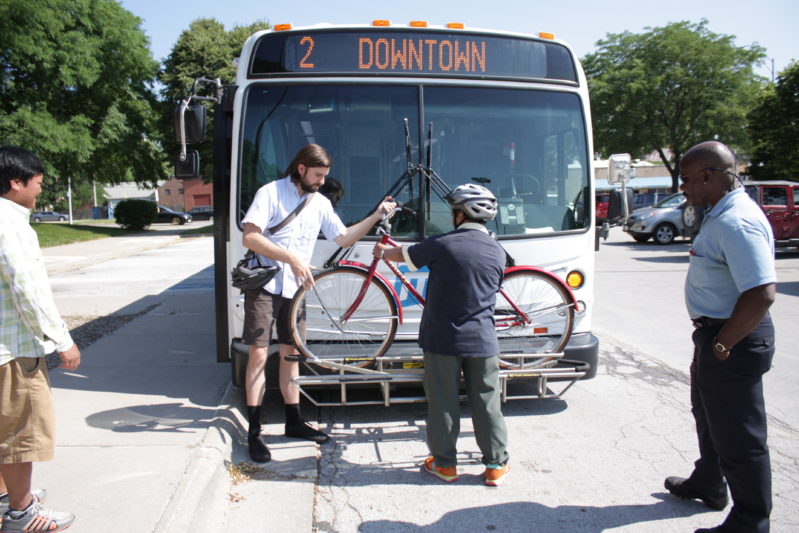Bike & Ride
Bring Your Bike Along
All buses and ORBT vehicles are equipped with racks for your bicycle — and your bike rides for free! Racks are available on a first-come, first-served basis and can accommodate wheel sizes of 16 inches or larger.
Bike racks DO accommodate:
- Two-wheeled bicycles weighing less than 55 pounds*, including purpose-built, electric bicycles with a sealed battery
- Heartland B-cycle bikes (check out their system map for dock locations!)
Bike racks DO NOT accommodate:
- Recumbent or tandem bicycles
- Tricycles or any three-wheeled bike
- Mopeds, electric scooters, or gas-powered bicycles
- Aftermarket or modified electric bicycles, including bikes with exposed components or unsealed batteries
- Bicycles that weigh more than 55 pounds*
- Bikes that do not fit fully and securely
Other notes:
- Metro is not responsible for damages incurred or caused to bikes while on buses or at bus stops, shelters, ORBT Stations, or transit centers
- You must be able to put your bike in the rack without assistance
- Operators will use discretion regarding allowable bicycles, including electric bikes
- Bike trailers are allowed on board if they can be folded to the size of a child’s stroller
*including equipment, components, gear, or other additions like panniers, racks, etc.
On the Bus
- Raise your hand to signal the driver to stop as the bus approaches. Before you step in front of the bus, make sure the bus is completely stopped and the driver sees you. Alert the driver you need to lower the rack.
- Remove all loose items, e.g. water bottles, panniers, saddlebags, air pumps, etc. before loading your bike on the rack.
- To lower the rack, squeeze the handle.
- Load your bike in the slot closest to the bus with the front wheel facing the curb. This is called the inside slot. If a bike is already loaded in the inside slot, load your bike with the rear wheel facing the curb.
- Tip: If only the outside slot is occupied, slide your bike into the inside rack from the curb side rather than trying to lift your bike over the other bike.
- Lift the support arm and raise it up over the front tire so the hook rests on the highest point of the wheel as close to the forks or fender as possible. Make sure the support arm is resting on the tire and not on the frame or fender.
- Tip for loading bikes with front wheel pegs: first pull up the support arm, then load the bike in the rack and position the support arm.
- Board the bus and deposit your fare. Your bike rides for free!
- Exit the bus at the front when you reach your stop and let your bus driver know you will be unloading your bike.
- Lift the support arm and fold down.
- Lift your bike out of the rack.
- If the rack is empty, please squeeze the handle and raise the rack up against the bus.
- Signal the driver once you and your bike have returned safely to the curb.
On ORBT
ORBT makes cycling easy — simply wheel your bike into a bike rack on board and you’re off! Cyclists should board through the rear door for closest access to the bike rack, and exit through the same door.
Bike parking and Heartland B-cycle stations are also available at select ORBT stations, making it easy to get where you need to go.
Rules for Loading and Unloading
- For your safety, load and unload the bike from the front or curb side of the bus.
- If someone wants to remove their bike, let them go first before you load yours.
- If the bus’s bike rack is full, you must wait for the next bus with an open rack slot to load your bike. Bikes are not permitted inside the Metro fleet, with the exception of ORBT.
- You must be able to load and unload your bike without assistance. Metro drivers cannot leave the driver’s seat to assist in the use of the bike racks.
- Bikes cannot be locked to the bus’s bike rack.
Bike Share and Electric Scooters
Heartland B-cycle bikes and electric scooters can be great tools for people to travel around town and to assist transit riders with the first or last mile of their trip.
If you use a scooter in Omaha to get to a bus stop or transit center, please keep Metro’s rules in mind:
- Be considerate when parking a scooter at or near a bus stop — make sure the stop is accessible to everyone.
- Non-foldable scooters are not allowed on board any Metro vehicles or on bus bike racks.
Bike Omaha Network
The 38-mile Bike Omaha Network is marked by easy-to-use wayfinding signs along shared streets, bike lanes and pathways throughout the metro area.
Omaha Bicycling Guide
For an even more comprehensive resource of available bike routes throughout Omaha, including safety tips and a list of local bike shops, check out MAPA’s handy interactive map.

Lost Bike?
Any claims for a bike left on buses or on other Metro properties (i.e. shelters, transit centers, the administrative building, parking lots, etc.) should be made to Metro by calling 402-341-0800 or by filling out our online comment form.
